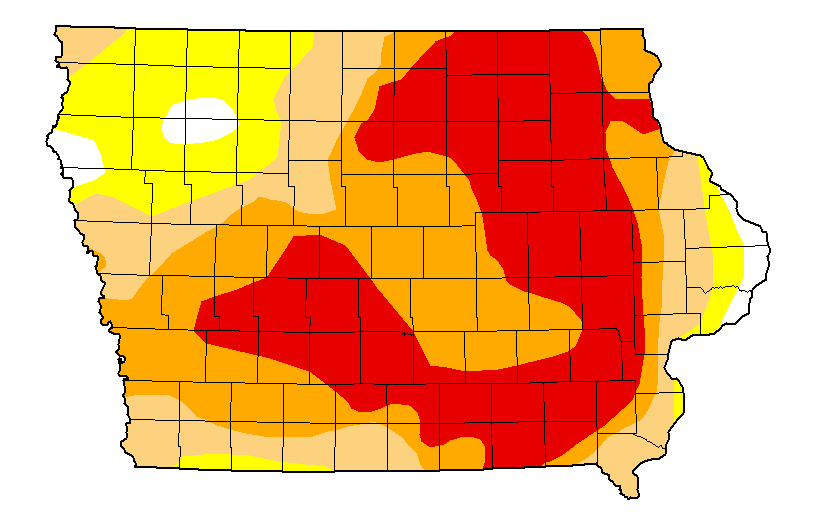Flooding is a common issue in Iowa, causing widespread damage to communities, infrastructure, and agriculture. Understanding the main causes of flooding in this state is crucial for better preparedness and response.
This article will break down the primary factors leading to flooding in Iowa.
Table of Contents
ToggleHeavy Rainfall

Heavy rainfall is the primary cause of flooding in Iowa, often leading to rapid rises in river and stream levels. In recent years, intense and prolonged rainstorms have resulted in significant flooding events.
Statistics and Data
- In June 2024, heavy rains in northwest Iowa caused widespread flooding. The West Fork Des Moines River experienced a substantial increase in water levels, with floodwaters inundating homes and farmlands.
- Historical data shows that the Cedar River in Cedar Rapids crested more than 11 feet above its previous record in June 2008, due to heavy rainfall, resulting in extensive damage to infrastructure and residential areas.
- The Turkey River at Elkader crested nearly 3 feet above major flood stage after heavy rains in August 2021, illustrating the impact of intense precipitation on river levels.
Heavy rainfall overwhelms the capacity of rivers and drainage systems, leading to overflow and flooding. This is particularly problematic when the ground is already saturated, as it limits the soil’s ability to absorb additional water, causing more runoff into rivers and streams. The combination of heavy rainfall and saturated soils creates a scenario where even moderate rain can lead to significant flooding.
The frequency and intensity of heavy rain events have been increasing, a trend linked to climate change. This necessitates better flood management practices and infrastructure improvements to mitigate the impact of such events on communities across Iowa.
Snowmelt

Snowmelt is another significant cause of flooding in Iowa, particularly in the spring when accumulated winter snow begins to thaw. The rapid melting of snow can lead to a surge in river and stream levels, especially when combined with spring rains.
Statistics and Data
- In the spring of 2019, Iowa experienced severe flooding due to a combination of rapid snowmelt and heavy rains. The Missouri River and its tributaries saw record water levels, leading to widespread flooding in western Iowa. This event affected 74 counties and caused over $1.6 billion in damage.
- The National Weather Service reported that in March 2019, the combination of snowmelt and rainfall led to unprecedented flooding along the Missouri River, with some locations experiencing water levels several feet above flood stage.
- During the spring of 2020, snowmelt contributed to flooding in northeastern Iowa, where the Turkey River and other local waterways experienced significant rises in water levels, exacerbating flood conditions caused by spring rains.
Snowmelt flooding is particularly challenging because it often coincides with the onset of spring rains. The thawing snow saturates the ground, reducing its ability to absorb additional rainfall. This leads to increased runoff and higher river levels, which can quickly overwhelm flood defenses and cause significant damage.
Effective flood management strategies in Iowa must account for the predictable yet variable nature of snowmelt. This includes maintaining and improving levees, monitoring snowpack levels, and preparing for rapid response when conditions indicate potential flooding. By understanding the patterns and impact of snowmelt, communities can better prepare and mitigate the risks associated with this natural phenomenon.
Topography and Soil Saturation
Topography and soil saturation are critical factors contributing to flooding in Iowa. The state’s relatively flat terrain and varying soil compositions play significant roles in how water is absorbed and retained in the ground, affecting flood patterns.
Statistics and Data

- Soil Composition and Permeability: The permeability of soil, which determines how much water can infiltrate the ground, is a major factor. Iowa’s soils vary widely; clay soils, for instance, have low permeability and do not absorb water quickly, leading to higher runoff during rain events. This can cause flooding, especially in areas where clay is prevalent. According to the Iowa Flood Center, soil types with low permeability can significantly increase surface runoff during heavy rainfall.
- Topographical Features: Iowa’s landscape includes both flat plains and rolling hills. Flat areas tend to have poor drainage, which can exacerbate flooding when heavy rains occur. Studies from Iowa State University highlight that soil erosion, driven by both topography and rainfall, reduces the soil’s capacity to absorb water over time, worsening flood conditions. For example, research has shown that areas with significant soil erosion experience increased runoff and higher flood peaks during rain events.
- Impact of Saturated Soils: Saturated soils from previous rain events or snowmelt limit the ground’s ability to absorb additional rainfall, leading to increased surface runoff and flooding. The U.S. Geological Survey has documented multiple large flood events in Iowa between 1960 and 2012, showing that areas with high soil saturation are more prone to flooding during heavy rainfalls. In one instance, saturated soils combined with heavy rainfall led to significant flooding along the Cedar River, causing widespread damage.
- Real-Time Monitoring: The Iowa Flood Information System (IFIS) provides real-time data on soil moisture and flood conditions, helping to predict and manage flooding by monitoring soil saturation levels across the state. This system integrates data from various sensors to give a comprehensive view of flood risks, allowing for better preparedness and response.
River Flooding
River flooding is a major cause of flooding in Iowa, particularly affecting areas near major rivers like the Mississippi and Missouri Rivers. These floods can be triggered by heavy rainfall, snowmelt, or a combination of both, leading to rivers exceeding their banks and causing widespread damage.
Statistics and Data
- Mississippi River Flooding: The Mississippi River has a long history of flooding, impacting many communities along its banks. For instance, the 2019 flooding event saw record water levels along the Mississippi, with several locations experiencing water levels several feet above flood stage. This event was driven by a combination of snowmelt and heavy rains, leading to significant agricultural and infrastructural damage.
- Missouri River Flooding: The Missouri River also poses a significant flood risk to Iowa. In March 2019, a powerful storm combined with rapid snowmelt led to historic flooding along the Missouri River. This event affected multiple states, including Iowa, causing widespread evacuation and property damage. The floodwaters inundated agricultural lands, disrupted transportation networks, and breached levees, emphasizing the vulnerability of regions along the Missouri River.
- Cedar River Flooding: The Cedar River is another major river in Iowa that frequently experiences flooding. The 2008 Cedar River flood was one of the most devastating in Iowa’s history, with the river cresting more than 11 feet above its previous record. This flood caused extensive damage to homes, businesses, and infrastructure in cities like Cedar Rapids and Waterloo.
- Impact of Infrastructure: Flood defenses such as levees and dams play a crucial role in managing river flooding. However, when these structures fail or are overwhelmed by water volume, the consequences can be severe. For example, levee breaches along the Missouri River during the 2019 floods exacerbated the flooding, highlighting the need for robust and well-maintained flood defenses.
- Climate Change: Climate change is expected to increase the frequency and intensity of river flooding events. Studies indicate that changing precipitation patterns and more extreme weather events will contribute to higher flood risks in the future. This underscores the importance of adaptive management strategies to mitigate the impact of river flooding on communities and ecosystems.
Levee Failures

Levee failures are a significant cause of flooding in Iowa, particularly along major rivers such as the Missouri and Mississippi Rivers. These structures are designed to protect against high water levels, but when they fail, the consequences can be catastrophic.
Statistics and Data
- 2019 Missouri River Floods: In March 2019, levee failures along the Missouri River led to severe flooding. Heavy rains combined with rapid snowmelt overwhelmed levees, resulting in widespread inundation. According to the Army Corps of Engineers, more than 50 levee breaches occurred, causing extensive damage to agricultural land, homes, and infrastructure. This event highlighted the vulnerability of aging levee systems and the need for maintenance and upgrades to these critical structures.
- Cedar River Flood of 2008: The Cedar River flood in 2008 also saw levee failures contributing to the disaster. The river crested at record levels, overwhelming local levees and flood defenses. This flood caused significant damage to the cities of Cedar Rapids and Waterloo, displacing thousands of residents and resulting in billions of dollars in damages. The levee breaches exacerbated the flooding, illustrating the importance of robust and well-maintained flood protection systems.
- Mississippi River Floods: The Mississippi River has experienced multiple significant flood events where levee failures played a crucial role. In 1993, a historic flood event saw numerous levee breaches along the river, leading to widespread flooding across several states, including Iowa. This event underscored the need for comprehensive floodplain management and improved levee infrastructure.
- Flood Defense Infrastructure: The effectiveness of levees depends on regular maintenance and timely upgrades. Studies by the American Society of Civil Engineers (ASCE) have rated the condition of U.S. levees poorly, with many in need of repair or replacement. In Iowa, local governments and agencies continuously work on improving levee systems, but funding and resources are often limited, posing challenges to ensuring long-term flood protection.
- Climate Change Impact: Climate change is expected to increase the frequency and intensity of flooding events, putting additional pressure on existing levee systems. As extreme weather events become more common, the risk of levee failures rises, necessitating proactive measures to strengthen flood defenses and enhance resilience against future floods.
Climate Change

Climate change significantly contributes to the increasing frequency and severity of flooding in Iowa. The changing climate affects weather patterns, precipitation rates, and temperature, all of which play crucial roles in flooding dynamics.
Statistics and Data
- Increased Precipitation: Climate change has led to an increase in the intensity and frequency of heavy rainfall events. According to the National Climate Assessment, the Midwest has seen a 37% increase in the amount of precipitation falling in heavy events since the late 20th century. This trend contributes to more frequent and severe flooding as rivers and streams overflow their banks more often due to the increased water volume.
- Temperature Rise and Snowmelt: Warmer temperatures associated with climate change result in earlier and more rapid snowmelt, which can cause rivers and streams to swell quickly, leading to flooding. Studies from the Iowa Flood Center indicate that these earlier snowmelts combined with spring rains amplify the flood risks.
- Extreme Weather Events: Climate change is linked to the increase in extreme weather events such as storms and heavy rainfall, which exacerbate flooding. The Environmental Protection Agency (EPA) reports that the frequency of severe storms has increased, resulting in higher instances of flash flooding and prolonged flood events in the Midwest, including Iowa.
- Changing River Flows: Alterations in seasonal river flows due to climate change impact the flood risk. For example, earlier spring flows and higher peak flows during storm events contribute to more frequent flooding. The U.S. Geological Survey has documented changes in river flow patterns in Iowa, correlating them with increased flood incidents.
- Impact on Flood Management: The increasing unpredictability of weather patterns due to climate change challenges existing flood management strategies. Infrastructure designed based on historical weather patterns may no longer be adequate, necessitating updates and enhancements to cope with the new realities brought by climate change.
- Future Projections: Projections suggest that climate change will continue to intensify flooding risks in Iowa. The Fourth National Climate Assessment predicts further increases in heavy precipitation events, potentially leading to more severe and frequent flooding. This underscores the need for adaptive flood management practices and infrastructure improvements to mitigate future impacts.
Urbanization and Land Use Changes

Urbanization and land use changes are significant contributors to flooding in Iowa. The transformation of natural landscapes into urban areas affects how water is absorbed and managed, often leading to increased surface runoff and higher flood risks.
Statistics and Data
- Impervious Surfaces: Urban areas typically feature a high percentage of impervious surfaces such as roads, sidewalks, and buildings. These surfaces do not absorb water, leading to increased runoff during rainfall. The Environmental Protection Agency (EPA) notes that urbanization can increase the volume and speed of runoff, overwhelming stormwater systems and causing flash flooding.
- Reduction of Natural Floodplains: Development in floodplain areas reduces the land’s natural ability to absorb and manage floodwaters. According to the Iowa Department of Natural Resources, many floodplain areas in Iowa have been developed for residential, commercial, and agricultural use, reducing their capacity to mitigate flooding naturally.
- Drainage Systems: Urbanization often involves the construction of drainage systems to manage stormwater. However, these systems can become overwhelmed during heavy rain events, especially if they are not designed to handle the increased runoff from extensive impervious surfaces. Inadequate stormwater management infrastructure is a common issue in many growing urban areas in Iowa.
- Wetland Destruction: Wetlands act as natural sponges, absorbing excess water and reducing flood risks. The conversion of wetlands to agricultural or urban land diminishes this natural flood protection. The U.S. Geological Survey highlights that the loss of wetlands in Iowa has significantly reduced the landscape’s ability to manage floodwaters.
- Case Study – Des Moines: Des Moines, the capital city of Iowa, has experienced increased flooding due to urbanization. Studies indicate that the city’s rapid growth and development have led to higher runoff and more frequent flood events. The Des Moines metropolitan area has seen several significant floods over the past decades, emphasizing the impact of urbanization on flood risk.
- Green Infrastructure Solutions: To combat the effects of urbanization on flooding, cities in Iowa are increasingly adopting green infrastructure solutions. These include rain gardens, permeable pavements, green roofs, and restored wetlands, which help to absorb and manage stormwater more effectively. For example, Cedar Rapids has implemented green infrastructure projects to reduce flood risks and improve stormwater management.
Infrastructure Issues
Infrastructure issues are another critical factor contributing to flooding in Iowa. Aging, inadequate, or poorly maintained infrastructure can exacerbate flood risks, leading to significant damage during flood events.
Statistics and Data
- Aging Infrastructure: Many of Iowa’s flood control structures, such as levees and dams, were built decades ago and may not meet current engineering standards. According to the American Society of Civil Engineers (ASCE), the infrastructure in many parts of the United States, including Iowa, is aging and requires significant investment to ensure it can handle modern flood risks. Levees, in particular, are often highlighted as needing upgrades to withstand the increasing frequency and intensity of flood events.
- Inadequate Stormwater Systems: Urban areas in Iowa often struggle with inadequate stormwater management systems. These systems can become overwhelmed during heavy rain events, leading to urban flooding. Studies indicate that many cities in Iowa need to expand and improve their stormwater infrastructure to cope with the higher volumes of runoff caused by urbanization and more frequent heavy rainfall.
- Levee Failures: As previously mentioned, levee failures can lead to catastrophic flooding. The 2019 Missouri River floods were exacerbated by multiple levee breaches, highlighting the need for better maintenance and monitoring of these critical structures. The Army Corps of Engineers has noted that many levees in the Midwest are at risk of failure due to insufficient funding for maintenance and upgrades.
- Dam Safety: Dams are also a significant concern in Iowa. The National Inventory of Dams has identified several dams in the state as being at high hazard potential, meaning their failure could result in significant loss of life and property damage. The maintenance and inspection of these dams are crucial to preventing flood-related disasters.
- Transportation Infrastructure: Flooding can severely impact transportation infrastructure, including roads, bridges, and railways. For instance, the 2008 floods in Iowa caused extensive damage to transportation networks, disrupting travel and commerce. Ensuring that roads and bridges are resilient to flooding is essential for maintaining connectivity and safety during flood events.
- Funding and Resources: One of the biggest challenges in addressing infrastructure issues is the lack of funding and resources. Many local governments in Iowa struggle to allocate sufficient funds for the necessary upgrades and maintenance of flood control infrastructure. Federal and state assistance is often required to support these efforts.
Agricultural Practices

Agricultural practices in Iowa significantly contribute to the state’s flooding problems. The methods and changes in land use associated with agriculture can alter the natural water absorption and flow, leading to increased flood risks.
Statistics and Data
- Deforestation and Land Clearing: Large-scale deforestation and land clearing for agricultural purposes reduce the land’s ability to absorb rainwater. Forests and natural vegetation act as sponges, soaking up excess rainwater and reducing runoff. The conversion of these lands to agricultural fields increases runoff, leading to higher river and stream levels during heavy rains. According to the U.S. Department of Agriculture (USDA), the loss of natural vegetation in favor of crops has significantly altered the hydrology of the region.
- Soil Erosion: Intensive farming practices contribute to soil erosion, which diminishes the soil’s capacity to absorb and retain water. Eroded soils are less permeable and more likely to contribute to surface runoff. The Iowa Department of Natural Resources (DNR) has highlighted that soil erosion, particularly on sloped farmland, is a major factor in increased flood risks.
- Tile Drainage Systems: Many Iowa farms use tile drainage systems to remove excess water from the soil. While these systems are essential for maintaining crop health, they can also increase the speed at which water is directed into rivers and streams, reducing the natural absorption and filtration processes that would normally mitigate flooding. Research from Iowa State University shows that tile drainage significantly alters the timing and volume of runoff, contributing to flood peaks.
- Monoculture and Crop Rotation: The practice of monoculture, where the same crop is grown year after year, reduces soil health and its ability to retain water. Crop rotation, which is less commonly practiced in some areas, helps improve soil structure and water retention capabilities. Studies have shown that diverse cropping systems can enhance soil health and reduce runoff, thereby lowering flood risks.
- Chemical Inputs: The use of fertilizers and pesticides can also impact soil structure and health. Excessive use of these chemicals can lead to soil compaction and reduced infiltration rates, exacerbating flooding issues. The Environmental Protection Agency (EPA) notes that sustainable agricultural practices are essential for maintaining soil health and reducing flood risks.
- Conservation Practices: Implementing conservation practices, such as cover cropping, no-till farming, and buffer strips, can significantly reduce the impact of agriculture on flooding. These practices help maintain soil structure, increase water infiltration, and reduce runoff. The Natural Resources Conservation Service (NRCS) promotes these practices to help mitigate the effects of agriculture on flooding.
Conclusion
Flooding in Iowa is a complex issue driven by multiple factors, including heavy rainfall, snowmelt, topography and soil saturation, river flooding, levee failures, climate change, urbanization, agricultural practices, and floodplain management. Understanding these causes is crucial for developing effective strategies to mitigate the impacts of flooding on communities, infrastructure, and the environment.















